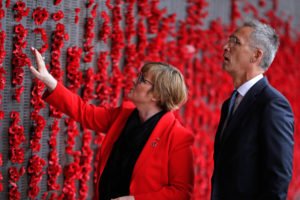Ministerial Statement on the Centenary of ANZAC – 13th May 2015
Senator REYNOLDS (Western Australia) (17:24): I rise to take note of the ministerial statement on the Centenary of Anzac and the Anzac celebrations at Anzac Cove this year. Last night I was very fortunate to be able to share with this place my story and my family’s story of our pilgrimage to Gallipoli as four of the very lucky ballot holders to go and join in the ceremonies there. I shared a little bit about my own family journey and the family story of our experience in learning more about my grandfather, who never talked about war and never valued any of his mementos or anything that reminded him of his four years in war.
One of the most wonderful things that I think has happened very organically now is that, through the Centenary of Anzac activities, we are capturing more and more of the individual stories of the men and women who served in World War I. While the stories of many of these servicemen in particular are now lost to time, save a family’s note to them on their gravestone or their service records, wonderfully, what I have experienced myself now is that, through historians and the increasing work of families, people are going back and trying to recover and preserve as much of the family history of their World War I veteran relatives as they possibly can. How that is now evolving is truly a wonderful thing.
For example, before I went to Gallipoli, I attended several RSL Anzac Day ceremonies. One of the things that was very clear is that, even at the local community level, not just through RSLs but through schools and other community groups, people are now looking very carefully and closely at who served in their local community. They are capturing the stories of very ordinary Australians who did extraordinary things in the service of their country in World War I.
For example, in the RSL in my local area of Kalamunda in Perth I found the story of Sister Agnes Tait, who was from Carmel in the hills. She was the only woman on the Kalamunda and districts RSL honour roll. Sister Tait, against her parents’ wishes, trained as a nurse at the Perth public hospital and joined the Australian Army Nursing Service on 23 August 1915. Sister Tait served in Egypt, at a casualty clearing station in France and at base hospitals across Europe and England. She spent years tending to the dead, dying and critically injured. She spent the last two years of the war on a Red Cross hospital ship, comforting those who were finally returning home. Like everybody else, she eventually returned home—in this case, to Kalamunda—where she remained for the rest of her life, serving the community as a nurse. Sister Tait is just one of the thousands of examples of local community members who are being remembered.
I was also very fortunate to launch in Fremantle on behalf of the Minister for Veterans Affairs a wonderful book called Fremantle voices of the Great War. This was an astonishing achievement by Mr Pittaway and the Army historical society. They discovered that over 3,000 young men left the Fremantle community for the Great War and nearly a third of them never returned home. It is a wonderful book that captures what it was like at the time in Fremantle. The historians spent many years working with families, going through their records and pulling out family oral histories. It is a most remarkable record of the Fremantle community.
Melissa Parke, the member for Fremantle, was also at the launch. Interestingly, by sharing my story of my grandfather and her sharing her story of her great-uncle, we realised that the two of them served together at Gallipoli. In fact, they were both in the 3rd Field Ambulance, my grandfather leaving from Albany and her greatuncle leaving from Fremantle. They must have known each other and served together, tending the wounded and the dying at Gallipoli. You just never know quite where these linkages are going to come from.
My story that I shared last night and the thousands of other stories that are now coming to light not only help families preserve the memory of their family members, sometimes three generations ago now, but also make sure that these men and women are remembered. When we come together as a nation to commemorate all those who have served—not just those in World War I but in World War II, all the other conflicts we have been involved in and those we are involved in today—it gives families the understanding and ability to make sure that they capture the stories when they can. That is one of the many wonderful things that the Centenary of Anzac program is delivering to this nation. (Time expired)



